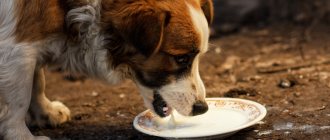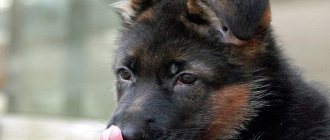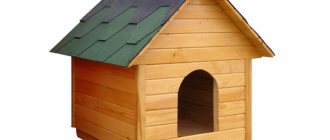Are there any indications?
Dogs of this breed were almost always tailless. Puppies had their spinal appendage cut off in the first days of life, and this was done for several reasons:
- Rottweilers took part in dog fights.
- Dogs drove cattle and protected them from predators.
- From an early age, the puppy was made into a guardian of the home and family.
In all these cases, the long tail got in the way of the dog and made it vulnerable. The predator could grab onto it and disorient the dog, causing him serious damage at this time. Another argument of docking advocates is that without a tail, the Rottweiler looks more aggressive.
Some breeders believe that the spinal appendage is a hindrance for this breed. Rottweilers have been docked for centuries, so there is an opinion that nature has inherent in them the characteristics of a tailless existence. Dogs move, express emotions, and show aggression differently than animals that have not undergone surgery.
There are not many medical indications for docking Rottweilers. Basically, these are injuries that are incompatible with normal life activities. A dog without a tail can participate in exhibitions, since this option is prescribed in the breed standards, however, at international competitions, judges can find fault with such a dog.
Why is a Rottweiler's tail docked?
Rottweilers were bred artificially for baiting predatory animals, driving livestock, guarding territory and dog fighting. Using dogs for such purposes meant a high risk of injury. The tail is located in the defenseless zone of the animal's body. Predators or another dog could grab onto him and cause serious injuries. Therefore, docking was considered a necessity.
Today the procedure is not mandatory. Rottweilers are often kept simply for the love of her. They do not participate in battles, do not guard houses and livestock, and are not used for baiting. But many admirers of such dogs believe that the Rottweiler’s long tail looks ridiculous.
The breed standard is not limited to just the docking option. There are countries where only Rottweilers with uncut tails are allowed to exhibit. The standard involves docking from its base to two vertebrae. The decision about this is usually made by the breeder.
Sometimes tail trimming becomes necessary. It occurs when owners intend to attend Rottweiler shows or if the dog is injured. Docking of show specimens should be carried out on puppies before they reach the age of 6 months. Owners of the breed should remember that a Rottweiler without a tail may not be allowed to participate in international competitions. Therefore, before carrying out the procedure, you need to think about which exhibitions you plan to participate in.
There are contraindications to cupping. These include delayed age development of the puppy, the presence of diseases, deviations in the dog’s behavior - apathy, lack of appetite and unmotivated aggression.
Contraindications
The procedure cannot be performed if the puppy has abnormalities in growth and development. The operation is prohibited if the dog is sick, since a weakened immune system cannot cope with the increased load. It is advisable to postpone docking to a later date if the pet behaves strangely for no apparent reason - eats little, shows apathy or aggression.
Consequences of the procedure
At first glance, there is nothing wrong with removing the tail. The simplest operation, after which you only need to treat the wound for a couple of days. In fact, experiments conducted on rats show that nerve injury negatively affects the sensitivity of the stump. Some experts argue that removing the tail vertebrae weakens the animal's motor skills. Another weak point is urination. The tail serves as a counterweight. When an animal is deprived of it, it acquires dysfunction of the musculoskeletal system, as well as pathology of urinary function.
How to prepare your pet
If the operation is performed without anesthesia, then no special preparation will be required. It is only necessary to examine the puppy on the day of the procedure for rashes, bald spots and other signs of disease. There should be no strange fluids coming from the ears and eyes.
If the procedure is performed under general anesthesia, you will need to undergo tests in advance to make sure that the anesthesia will not harm you. 12 hours before surgery, the Rottweiler cannot be fed, only clean water can be given.
Does cupping affect life expectancy?
Docking a Rottweiler's tail does not affect its life expectancy. The operation, performed professionally, is well tolerated. The puppies quickly come to their senses and after a few hours they begin to play, eat with appetite and move actively. The only complications that can threaten a pet’s life are complications that occur when infections enter the pit, if the procedure was carried out incorrectly or the dog was already an adult. In such cases, inflammation sometimes develops, bleeding begins, and compactions form that can transform into malignant tumors. The risk of negative consequences of cupping is small. If done correctly, it comes down to zero.
Stages of the procedure
When performing an operation without anesthesia, it is better for the owner to hold the pet with his hands so that he does not escape, and the veterinarian carries out all the manipulations without errors. The procedure follows the following scheme:
- The tail is tightly tied with a strip of bandage closer to the base. This makes blood circulation in the appendage more difficult.
- An antiseptic is used.
- They feel the tail with their hands to mark the cutting line - it runs between two adjacent vertebrae.
- Using a scalpel or strong scissors, cut the tail along the intended line.
- Treat the wound with an antiseptic. If necessary, stitches are applied (small puppies do not need them).
- The bandage strip is removed half an hour after the operation.
The whole process lasts no more than 5 minutes. You can call a veterinarian to your home and carry out the procedure in more comfortable conditions for the dog, especially if it has already grown up. The operation scheme is no different from the clinic conditions.
It is not recommended to dock the tail yourself, since only a person with a veterinary education will do everything correctly. If the cut line is inaccurate, the dog will have a flaw for life; no corrections are provided. It is even possible to be disqualified from competitions and prohibited from mating.
Types of Rottweilers and descriptions
There are four Rottweiler breed standards registered in the world.:
- American.
- German.
- English.
- FCI standard (Federation Cynologique Internationale).
American breeders used German Rottweilers, which had certain deviations, to breed American standard dogs.
These were mainly dogs that were taller than their counterparts and had an aggressive character..
For American reasons, this breed was supposed to inspire fear and look impressive. She must do everything to protect the territory from those who encroach on it.
NOTE!
It is difficult for Rottweilers of the American variety to participate in various exhibitions due to deviations from the FCI standard.
Breeders of the English type Rottweilers also used German representatives of the breed when breeding. These two species are very similar to each other.
The only differences are in character . English Rottweilers, like their owners, are quite reserved and can remain cool in almost any situation. Exceptions are situations when one of the family members is at risk.
When drawing up the standard for the Rottweiler, the International Canine Federation relied specifically on the German type of this breed.
But in addition to the official ones, there are also unofficial types of this breed.
Almost every country had its own approach to breeding Rottweilers..
Rottweilers of the Finnish line have elongated muzzles and ears. This is explained by their crossing with Russian hounds to improve their sense of smell.
In Austria, this breed is used exclusively for military purposes. They are always on army territory and are raised and trained from different ages. This variety is shorter than German Rottweilers, better developed physically and has no subcutaneous fat.
There are no rules in the Italian Rottweiler breeding line. Therefore, they often have dogs with defects and abnormalities.
Italian Rottweilers are often called mini Rottweilers due to their build..
Price
The cost of docking does not depend on the breed - only on the age of the puppy. Rottweilers from 3 to 10 days have their tail trimmed for 500-800 rubles. For older dogs, the service will cost 1.5-2 thousand rubles. The price of anesthesia may be added to this if it is not included in the total amount. Calling a veterinarian to your home will add about 500 rubles to the price tag.
What does a puppy look like?
A Rottweiler puppy should generally look like a smaller version of an adult dog (below in the photo) .
He should move confidently, without swaying or limping. Their legs are straight and muscular, parallel to each other.
Up to three months, the puppy's head looks like a small copy of the head of an adult Rottweiler - a wide, short muzzle and a pronounced chin.
During adolescence, the proportions of the head may change.
The ears should be long and reach the middle of the cheekbones . They are triangular in shape and have a high, wide fit.
Until the puppy is one year old, the coat is straight and short, it should not curl. At an early age, it is allowed to be fluffy and soft.
Also, the brown tan on the fur is already quite clearly visible.
Small Rottweilers also have 28 baby teeth and a scissor bite..
Veterinarians' opinions
Dinara, 34 years old, Ryazan
“I think Rottweilers should definitely have their tail docked. It makes them look like non-pedigreed dogs, like an ordinary mongrel. For some reason, people think that they should leave what is given by nature. Only Rottweilers were bred artificially - what kind of nature are we talking about?”
Pavel, 38 years old, Samara
“I recently saw a long-tailed Rottweiler. Unusual, but interesting. I think that the owner himself should decide whether to dock the tail or not. Everyone has their own beliefs on this matter.”











